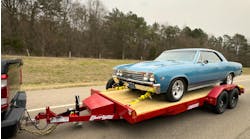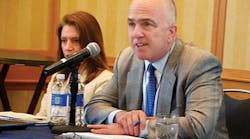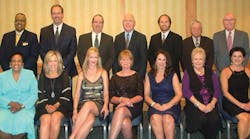BEWARE of the Federal Excise Tax (FET), says Mark H Sidman of Transport Counsel PC.
“FET on trucks, trailers, and tractors is difficult to apply,” he said. “It’s extremely fact-specific, and for a tax that occupies essentially three sections, it’s filled with traps. Given that the tax is 12% of the retail selling price, the stakes can be extremely costly. If you fail to charge tax when it’s due, then you have assessment exposures and end up in an FET audit, but it’s sometimes just as bad to charge it when it’s not due, because that is giving some of your competitors a 12% advantage in the marketplace.”
The presentation was the first FET seminar given at TTMA in “many years,” he said.
He provided the basic FET concepts:
• GVW threshold for trailers and semitrailers.
FET applies to chassis and bodies not suitable for use with a vehicle rated 26,000 lbs GVW or less. FET determination applies separately to the chassis and body.
GVW of chassis: generally established by the manufacturer; the IRS typically will accept the GVW rating, so long as it’s reasonable and not inconsistent with other documentation. If the GVW rating is different than the rating in an ad, invoice, or warranty agreement, the IRS will use the higher GVW rating.
GVW of body: There is a “suitable for use” test: the same model body is always taxable or always nontaxable regardless of the GVW of chassis it is installed on in a specific transaction.
• Taxable sales.
They are referred to as “retail” sales tax. However, the tax can apply to wholesale transactions, leases, and first uses.
FET generally applies to any sale, unless: the sale is for resale, and the purchaser provides a proper and timely resale certificate—if there is no certificate, a sale to a dealer can be taxable; the sale qualifies for a tax-free sale under IRC 4221 (eg, a sale to the state government, for export, etcetera); the article has been in a prior taxable sale, with the exception being a trailer or semitrailer chassis or body sold within six months after the article was previously sold in a taxable sale. If a chassis or body is sold within six months after the chassis/body was previously sold in a taxable sale, the second sale is still taxable, despite prior taxable sale. But the seller in the second sale can claim tax credit equal to the tax paid in the first sale. The claim form needs to include a signed statement that satisfies the requirements in Treasury Regulation 145.4052-1(a)(4) (eg, documentation regarding the tax amount paid by the prior taxpayer; the prior taxpayer has not repaid subsequent taxpayer the tax; and subsequent taxpayer does not consent to prior taxpayer claiming tax credit/refund). The credit cannot exceed the amount of tax due from the second sale.
• Parts and accessories.
Parts and accessories are taxable if they are sold on or in connection with a taxable article, and contribute to an article’s highway transportation function. Examples of equipment that contributes to transportation function: loading and unloading function; safety of vehicle; preservation of cargo (except refrigeration units); parts and accessories do not include equipment that is load of vehicle or spare/replacement parts; over-the-counter sales of parts and accessories generally is not taxable.
They are taxable if installed on a vehicle that has a taxable article within six months after the date the owner takes actual possession of the vehicle, subject to a couple of exceptions (six-month rule). The owner of the vehicle is primarily liable for the FET; the installer is secondarily liable.
• Marketing materials.
In an audit, the IRS often looks at a taxpayer’s marketing material to determine if they support the tax position the taxpayer is asserting. You should review marketing materials to make sure they are accurate and consistent with positions you are taking regarding FET. An example: Marketing materials that focus on an article’s versatility may undermine a taxpayer’s position that the article is primarily designed for a specific purpose (eg, feed, seed, and fertilizer).
• Further manufacturing.
So-called further manufacturing occurs when modifications to an article are sufficient enough for the IRS to treat the modifier as the manufacturer of new article. In such cases, the first sale or use after the modification may trigger FET. If a customer retains the title to an article throughout the modification process, the customer is likely responsible for FET.
Generally, these types of modifications constitute further manufacturing: change the transportation function; restore a wrecked vehicle into a usable vehicle; and extend a vehicle’s useful life.
To determine if such modifications constitute further manufacturing, you need to apply the so-called “75% Rule:” The article will not be treated as manufactured solely by reason of repairs or modifications to the article if: the cost of such repairs and modifications does not exceed 75% of the retail price of a comparable new article; and the article, when new, was taxable. In most situations, the cost of the modifications/repairs will not exceed the 75% threshold.
If the modifications involve primarily new components and only a few used components of the original vehicle are retained, proceed with caution. Recent IRS advice indicates the IRS will not apply the 75% Rule, even if the cost of modifications is less than the 75% threshold.
• Tire tax credit.
Two rulings addressing the tire tax credit; the credit does not reduce the FET liability for a given transaction, but the total tax liability the taxpayer owes the IRS; in identifying FET owed on Form 720, line 33, credit should not be netted against FET; instead, credit should be separately noted on Schedule C.
Invoicing issues: The 2002 IRS memorandum indicates you should set the sale price—either to include or exclude the amount of the credit—and then calculate FET; do not deduct the credit from the sale price after the tax has been calculated; the 2002 ruling states that the taxpayer is not required to provide information regarding the tire tax credit on invoice.
These types of tax-free sales (IRC 4221) are based on: the identity of the purchaser or the use/disposition of the article. Tax-free sales include: certain sales to state or local governments; certain sales for export; certain sales for further manufacture; certain sales for supplies for vessels or aircraft; certain sales to qualified blood collector organizations; and certain sales to nonprofit educational organizations.
Each type of Section 4221 tax-free sale has its own specific requirements. Sellers (and in some cases, purchasers) need to be registered with the IRS (IRS form 637).
In sales to a state or local government: the sale must be directly to the state or local government (not sale for resale); the sale must be the article’s first use (ie, not previously sold or used); the sale must be for the exclusive use of the state or local government (not intended to re-sell, even to its employees); determination if a quasi-governmental purchaser qualifies; does not apply to federal government agencies; a certificate is obtained from the purchaser in the form required by IRS regulations (different from resale certificate); a certificate is obtained at or prior to the sale; certain language on the purchase order.
IRS regulations exempt a variety of specialized trailers and equipment, Sidman said. He warned, however, that there are some common traps in the exemption, including narrow interpretations of the exemption by the IRS, revocation of several older rulings finding exemption applied. ♦










